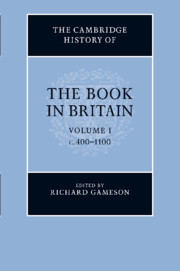Book contents
- Frontmatter
- 1 From Vindolanda to Domesday: the book in Britain from the Romans to the Normans
- PART I THE MAKING OF BOOKS
- PART II THE CIRCULATION OF BOOKS
- PART III TYPES OF BOOKS AND THEIR USES
- 15 The book in Roman Britain
- 16 The use of the book in Wales, c. 400–1100
- 17 The biblical manuscripts of Anglo-Saxon England
- 18 Anglo-Saxon gospel-books, c. 900–1066
- 19 Liturgical books
- 20 Anglo-Saxon prayerbooks
- 21 Psalters
- 22 Music books
- 23 Anglo-Saxon schoolbooks
- 24 Law books
- 25 Manuscripts of the Anglo-Saxon Chronicle
- 26 Old English homiliaries and poetic manuscripts
- PART IV COLLECTIONS OF BOOKS
- PART V CODA
- Bibliography
- Concordance of named manuscripts
- Index of manuscripts
- General Index
- Plate 4.1: The Lindisfarne Gospels"
- Plate 5.1: The Lichfield/St Chad Gospels"
17 - The biblical manuscripts of Anglo-Saxon England
from PART III - TYPES OF BOOKS AND THEIR USES
Published online by Cambridge University Press: 28 March 2012
- Frontmatter
- 1 From Vindolanda to Domesday: the book in Britain from the Romans to the Normans
- PART I THE MAKING OF BOOKS
- PART II THE CIRCULATION OF BOOKS
- PART III TYPES OF BOOKS AND THEIR USES
- 15 The book in Roman Britain
- 16 The use of the book in Wales, c. 400–1100
- 17 The biblical manuscripts of Anglo-Saxon England
- 18 Anglo-Saxon gospel-books, c. 900–1066
- 19 Liturgical books
- 20 Anglo-Saxon prayerbooks
- 21 Psalters
- 22 Music books
- 23 Anglo-Saxon schoolbooks
- 24 Law books
- 25 Manuscripts of the Anglo-Saxon Chronicle
- 26 Old English homiliaries and poetic manuscripts
- PART IV COLLECTIONS OF BOOKS
- PART V CODA
- Bibliography
- Concordance of named manuscripts
- Index of manuscripts
- General Index
- Plate 4.1: The Lindisfarne Gospels"
- Plate 5.1: The Lichfield/St Chad Gospels"
Summary
Introduction
In the spring of 716 eighty monks, including the ailing Abbot Ceolfrith, left the twin monastery of Wearmouth-Jarrow in Northumbria, travelled down to the south coast and crossed the Channel to begin the long trek through France and over the Alps to Rome. Among the gifts for St Peter’s in their baggage was a huge Bible. It weighed about 32 kilos and was 250 mm thick, with 1,030 pages of 505 × 340 mm. On the verso of fol. 1 was a florid dedicatory inscription in Latin metres:
To the body of the illustrious Peter, justly to be honoured, whom lofty faith consecrates head of the church, I, Ceolfrith, abbot from the farthest ends of England, send tokens of my devoted feeling, desiring for me and mine that we may have for ever a remembered place in the heavens, among the joys of so great a father.
The abbot died in France during the journey, but the bible appears to have reached St Peter’s. It survives today in Florence and is known as the Codex Amiatinus, having spent many years at the monastery of San Salvatore at Monte Amiata. As the earliest surviving complete Vulgate Bible anywhere, its importance is inestimable and it is one of the greatest monuments of English book-making.
At almost the same time that the Northumbrian monks were heading for Rome, the Anglo-Saxon missionary Boniface, from Wessex, was beginning forty years of work among the heathen Germans. From time to time he would write home with requests for books , and in one letter he asked Eadburh, abbess of Minster-in-Thanet , Kent, to copy out for him, in letters of gold, ‘the Epistles of my lord, St Peter, that a reverence and love of the Holy Scriptures may be impressed on the minds of the heathens to whom I preach’.
Keywords
- Type
- Chapter
- Information
- The Cambridge History of the Book in Britain , pp. 406 - 435Publisher: Cambridge University PressPrint publication year: 2011
- 4
- Cited by

